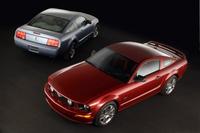New Car Review: 2005 Ford Mustang GT
THE AUTO PAGE
By
JOHN HEILIG
SEE ALSO: New Car Buyer's Guide for Ford
SPECIFICATIONS
MODEL: 2005 Ford Mustang GT
ENGINE: 4.6-liter V8
HORSEPOWER/TORQUE: 300 hp @ 5,750 rpm/320 lb-ft @ 4,500
rpm
TRANSMISSION: 5-speed manual
FUEL ECONOMY: 17 mpg city/25 mpg highway
WHEELBASE: 107.1 in.
LENGTH/WIDTH/HEIGHT: 188.0 x 73.9 x 55.4 in.
TIRES: P235/55ZR17
BASE PRICE/STICKER: $24,995 (base)
Few cars can qualify these days as true icons. There is the Corvette and, well, the only other one is the Ford Mustang. Ford is so sure of the iconic nature of its pony car that the 2005 version carries no name on it. Sure, there's the prancing pony in the grille, but unless you order a "Mustang" decal for the rocker panels, there is no name on the car. Of course, when we drove the new Mustang anywhere, people recognized it for what it was. And in general, people liked the redesign. One SUV driver even told us to congratulate Ford for keeping the iconic nature of the car.
The design of the new car holds true both to the original and to the 1994 redesign. For a while, Mustangs were trending toward just another compact car. The 1994 redesign changed that, but there was a lot of that trend even in 2004 with the V6-powered, automatic transmissioned version. But at least the `04 car looked like a Mustang; the `93 looked like any other compact coupe. The new Mustang is more than just design. It is available in two versions as before. There's the V6-powered Mustang with a 4.0-liter V6 delivering a relatively low 210 hp. Then there's the V8-powered car we drove, with 300 horses (Mustangs?) under the hood and a five-speed manual gearbox. It would have been nice to have had a six-speed shifter, but only the five-speed is available. Rev the engine and pop the clutch and the Mustang leaps away from stop signs and traffic lights. But the true character of the car can best be shown on winding mountain roads, and Ford chose the mountains and canyons north of Los Angeles to demonstrate the Mustang's prowess. Despite a fairly conservative MacPherson strut front suspension and a relatively archaic solid rear axle with a three-link suspension, the Mustang is extremely well-balanced under hard driving. During one 10-mile stretch, we were in tandem with a Corvette. I hesitate to say we were racing, because we weren't, but we were both having a ton of fun driving at about eight-tenths of our abilities. Our fun came to a halt when we came upon another `05 Mustang that was stuck behind a Toyota Corolla that wouldn't move over. When we finally separated from the Corvette, we gave each other a friendly wave to say it had been fun.
During that run, and during runs that followed, the Mustang showed that is capable of dealing with hard and fast corners without the harshness you often find in good sporty cars.
The interior design is also true to the car's heritage. The steering wheel is pure 1965, and the instruments are set in deep nacelles, much like the original. Of course, today's car has as original equipment a tachometer, which was only available as part of a "Rallye Pack" from your dealer. It's a much more sporty dash design than in the `04 version, even the Cobra.
We also had a chance to drive an `04 Cobra Mustang recently, and it pales compared to the `05 GT. Sure, the Cobra has about 50 more horsepower and a six-speed gearbox. But the shifter is almost under the dash and is difficult to use. The suspension is rock hard and isn't compliant. With a more civilized `05 GT, I believe overall street performance is equivalent or better than the Cobra. The Cobra DID sound better, though.
I wasn't overly thrilled with the ribbed aluminum background to the dash, but compared to the plastic version in the `04, it's a great improvement. It's a little "techier" than the `04 and in that sense it's better.
You don't buy a Mustang because you want to carry rear-seat passengers a long way. That's good, because rear-seat room is minimal. It's a lot better than some sports cars we've driven that claim to be 2+2s, but still not ideal for long trips. I think the rear seat in my `65 was better. I was impressed by the interest the new Mustang generated. People stopped us on the initial test ride, and people stopped me back home when they learned I had driven it and wanted to know all about it. This is the sign of a true icon.
© 2005 The Auto Page Syndicate



